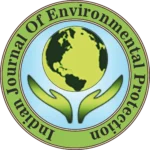IJEP 44(11): 1051-1056 : Vol. 44 Issue. 11 (November 2024)
Abhishek Kumar and C. Ravichandran*
Bishop Heber College (Autonomous) (Affiliated to Bharathidasan University), Department of Environmental Sciences, Tiruchirappalli – 620 017, Tamil Nadu, India
Abstract
Electronic waste includes precious elements that can be recycled with economic value. However, most of the electronic waste is recycled in the informal sectors. Electronic waste dismantling activities and informal disposal are non-point sources of surface water pollution. Surface water, mainly lakes, is interconnected by a network of water drains in Bengaluru city. Sediment samples (0-15 cm) were collected from Bellandur lake for the current study. The samples were digested and subjected to atomic absorption spectroscopy and inductively coupled plasma-mass spectroscopy (ICP-MS). The study area has heavy metal pollution since the pollution load indices are higher than unity. Moreover, a toxic response factor was applied to assess the potential ecological risk of heavy metals. The potential ecological risk indices of the sediment indicate an increasing order of the heavy metal concentrations of cadmium>copper>lead>chromium (VI), respectively. The contamination level for lead and chromium is low, copper is moderate and cadmium levels are extremely high. The analysis of the sediments in Bellandur lake shows significant potential ecological risk of heavy metals.
Keywords
Electronic waste, Informal sectors, Bellandur lake, Heavy metals, Ecological risk
References
- Sengupta, D., et al. 2022. Circular economy and household e-waste management in India: Integration of formal and informal sectors. Eng., 184: 107661.
- Perkins, D.N., et al. E-waste: A global hazard. Annals Global Health. 80(4): 286-295.
- Garg, N. and D. Adhana. 2019. E-waste management in India: A study of current scenario. J. Manage. Tech. Eng., IX(1).
- Rajesh, R., D. Kanakadhurga and N. Prabaharan. 2022. Electronic waste: A critical assessment on the unimaginable growing pollutant, legislations
and environmental impacts. Challenges. 7: 100507. - Sussman, H.S., A. Raghavendra and L. Zhou. 2019. Impacts of increased urbanization on surface temperature, vegetation and aerosols over Bengaluru, India. Remote Sens. Appl. Soc. Env., 16: 100261.
- Vaddiraju, A.K., S. Sangita and K.S. Sridhar. 2016. Urban governance in Karnataka and Bengaluru: Global changes and local impacts. Cambridge Scholars Publishing.
- Aithal, B.H. and A.A. Lone. 2013. Conservation of Bellandur wetlands: Obligation of decision makers to ensure intergenerational equity. ENVIS technical report no 55. Environmental Information System (ENVIS), Indian Institute of Science, Bangalore, India.
- Ramachandra, T.V., et al. 2018. Spatial patterns of heavy metal accumulation in sediments and macrophytes of Bellandur wetland, Bangalore. Env. Manage., 206: 1204-1210.
- Egüven, D. and G. Akinci. 2011. Comparison of acid digestion techniques to determine heavy metals in sediment and soil samples 24. Gazi University J. Sci., 24(1): 29-34.
- Khaliq, A., et al. Metal extraction processes for electronic waste and existing industrial routes: A review. Australian perspective. 3: 152-179.
- Jorfi, S., et al. Pollution load index for heavy metals in Mian-Ab plain soil, Khuzestan, Iran. Data Brief. 15: 584-590.
- Tomlinson, D.L., et al. Problems in the assessment of heavy-metal levels in estuaries and the formation of a pollution index. Helgoländer Meeresuntersuchungen. 33: 566-575.
- Sivakumar, J., et al. Assessment of heavy metal enrichment and the degree of contamination in coastal sediment from southeast coast of Tamil nadu, India. J. Heavy Metal Toxicity Diseases. 1(2): 1-8.
- Hakanson, L. 1980. An ecological risk index for aquatic pollution control. a sedimentological approach. Water Res., 14(8): 975-1001.
- Harikumar, P.S., U.P. Nasir and M.P. Mujeebu Rahman. 2009. Distribution of heavy metals in the core sediments of a tropical wetland system. J. Env. Sci. Tech., 6(2): 225-232.
- Gargouri, D., et al. 2023. Use of sediment quality indicators for heavy metals contamination and ecological risk assessment in urbanized coastal zones. Earth Sci., 77(10): 1-8.
- Liu, Y., et al. Calculation of Thallium’s toxicity coefficient in the evaluation of potential ecological risk index: A case study. Chemosphere. 194: 562-569.
- Li, W. and V. Achal. 2020. Environmental and health impacts due to e-waste disposal in China- A review. Total Env., 737: 139745.
- Fiori, C.S., et al. 2013. Ecological risk index for aquatic pollution control: a case study of coastal waterbodies from the Rio de Janeiro state, southeastern Brazil. Geochimica Brasiliensis. 27(1): 24-24.
- Rashed, M.N. 2001. Cadmium and lead levels in fish (Tilapia nilotica) tissues as biological indicator for lake water pollution. Monit. Assess., 68(1): 75-89.
- Wieczorek, J., et al. 2018. Assessment of the pollution and ecological risk of lead and cadmium in soils. Geochem. Health. 40(6): 2325–2342.
- Xu, Y., et al. 2017. The current status of heavy metal in lake sediments from China: Pollution and ecological risk assessment. Evol., 7(14): 5454-5466.
- Wong, C.S.C., et al. 2007. Evidence of excessive releases of metals from primitive e-waste processing in Guiyu, China. Poll., 148(1): 62-72.
